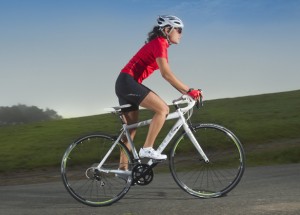How to determine your optimal weight?
 Ever since I started riding four and a half years ago my weight has been very stable but I also know that if I lost a few kilos I would be faster and go up hills better. So I read with interest an article from one of my favourite women’s online cycling magazines Women’s Cycling.ca and the editor Laurel-Lea kindly agreed that I could reproduce it here.
Ever since I started riding four and a half years ago my weight has been very stable but I also know that if I lost a few kilos I would be faster and go up hills better. So I read with interest an article from one of my favourite women’s online cycling magazines Women’s Cycling.ca and the editor Laurel-Lea kindly agreed that I could reproduce it here.
So here it is by Diane Stibbard…….
Q: How do I determine my optimal weight so I’m strong and fit on my bike?
A: Everyone has a different body physiology as well as different cycling goals: your genetic makeup affects your ability to lose and gain weight and to gain lean muscle mass. However, your body weight, lean muscle mass, body-fat percentage, body-mass distribution, and body-fat distribution all play a big role in your performance on the bike.
Different Body Types
In the world of cycling, there are basically three different body types. One is very muscular and powerful. These people do well riding on mostly flat terrain, and tend to be good sprinters because of their big and powerful legs.
The second body types are “hill climbers.” These cyclists tend to be shorter, and typically very light, with low body-fat percentages. But simply being short and extremely light won’t make you a good hill climber. A cyclist who wants to excel at hills also needs to have what is known as a high power-to-weight ratio, meaning they have the strength and ability to generate big power in relationship to their body weight. That’s critical for sustaining the raw power necessary to climb steep inclines over long distances without getting fatigued to the point of exhaustion.
There is also a “middle cycling body type.” This is a term I use to describe a cyclist who is in-between a very lean and light hill climber and a big, strong, powerful sprinter. Time-trialists typically have this type of body. They need the power of a sprinter to sustain speed but at the same time they can’t be too heavy. Pushing extra body weight on any terrain makes riding that much harder.
So where does that leave us?
What’s common to all these body types is the necessity for leg strength. That’s because the leg muscles provide all the energy for forward motion. Therefore, your weight distribution is important. You require the largest percentage of muscle mass in your legs, and less in your upper body. But you still need to have a strong back to support your body while riding, to maintain good posture and to help prevent soreness in neck and lower back muscles.
Body physiology is important, but how much body fat you carry is equally important. Excess body fat is “dead weight,” which simply means weight that doesn’t contribute to strength, power or speed. Body-fat percentages for female competitive cyclists are around 12 to 16%. For the average female it’s around 18 to 25%.
So how do we work with what our genes have given us, without carrying extra body fat?
The answer to that question lies in what you eat and how much. All cyclists need to fuel their bodies with high-quality, unprocessed carbohydrates, lean proteins, good unsaturated fats, and a variety of vegetables and fruits. But we each need different amounts.
If you determine that your body-fat ratio is too high for your body type, you should focus on reducing your serving sizes. In addition to that you should cycle at least 3 hours per week, and do 1 to 2 weight training sessions to maintain lean muscle mass and core body strength. If you need to lose weight I recommend keeping a daily food diary, which will give you helpful information about what foods you are eating and how much. Optimum weight is determined by the amount of calories consumed relative to how many calories are being expended on the bike. Also, there are specific “power and strength” workouts on the bike that can be added to your weekly training rides to help you not only lose extra body fat but to become a stronger, more powerful cyclist.
Those who want to maintain their current body weight but want to become stronger and more powerful on the bike need to consume a consistent amount of good-quality food to keep calories coming in at regular times throughout the day. That, along with the addition of power- and strength-specific workouts on the bike, will help you to achieve your goals.
To summarise, you can’t change your body type. But you can keep your diet “clean” from highly-processed foods, saturated fats, and sugar-loaded carbs. To keep your body lean, yet strong, eat good-quality, slow-burning carbohydrates, lean proteins, and ample vegetables and fruits.
So get lean, keep fit and ride strong.
